Trace Elements and Pb-O Isotopes of Scheelite: Metallogenic Implications for the Shimensi W-Polymetallic Deposit in South China
Abstract
:1. Introduction
2. Regional Geological Background
3. Deposit Geology
4. Sampling and Analytical Methods
4.1. Sampling
4.2. Analytical Methods
5. Results
5.1. Scheelite Geochemistry
5.1.1. Cathodoluminescence Image
5.1.2. Major and Trace Elements
5.2. Lead Isotopes
5.3. Oxygen Isotope Compositions
6. Discussion
6.1. Substitution of REE for Ca in Scheelite
- ①
- 2Ca2+ = REE3+ + Na+;
- ②
- Ca2+ + W6+ = REE3+ + Nb5+;
- ③
- 3Ca2+ = 2REE3+ + □Ca (□Ca = Ca-site vacancy).
| Sample No. | Mineral | δ18Oscheelite (‰) | δ18Owater (‰) |
|---|---|---|---|
| SMT1 | Scheelite | 6.1 | 7.7 |
| SMT2 | Scheelite | 5.4 | 7.4 |
| SMT3 | Scheelite | 4.8 | 7.2 |
| SMT4 | Scheelite | 5.9 | 8.4 |
| SMT5 | Scheelite | 4.3 | 7.0 |
| SMT6 | Scheelite | 6.4 | 9.2 |
| SMT7 | Scheelite | 6.4 | 9.4 |
| SMT8 | Scheelite | 6.5 | 9.6 |
| SMT9 | Scheelite | 5.6 | 8.8 |
6.2. Sources and Evolution of the Ore-Forming Fluid
6.3. Provenance of Metals
7. Conclusions
- (1)
- The acquired data reveal that 3Ca2+ = 2REE3+ + □Ca (□Ca = Ca-site vacancy) was the principal substitution mechanism responsible for the REE fixation occurring in the Shimensi scheelite.
- (2)
- The Shimensi ore-forming fluid was mainly sourced from magmatic water, which possibly mixed with meteoric water in the late ore stage. The early-stage and late-stage ore-forming fluids may have been relatively rich in F− and HCO3−, respectively, and evolved from reducing to oxidizing.
- (3)
- The Pb isotope compositions of the metallic minerals were similar to those of the porphyritic/fine-grained biotite granites. The main-stage ore-forming materials were consequently derived from these Mesozoic biotite granites.
Supplementary Materials
Author Contributions
Funding
Data Availability Statement
Acknowledgments
Conflicts of Interest
References
- Feng, C.Y.; Zhang, D.Q.; Xiang, X.K.; Li, D.X.; Qu, H.Y.; Liu, J.N.; Xiao, Y. Re-Os isotopic dating of molybdenite from the Dahutang tungsten deposit in northwestern Jiangxi Province and its geological implication. Acta Petrol. Sin. 2012, 28, 3858–3868. (In Chinese) [Google Scholar]
- Wang, P. Geology, Fluid inclusion, Stable isotope and molybdenite Re-Os Constraints on the Genesis of the Shimensi Tungsten Metallogenic deposit, Northern Jiangxi Province. Master’s Thesis, Sinosteel Tianjin Geological Academy, Tianjin, China, 2013; pp. 1–85. (In Chinese). [Google Scholar]
- Jiang, S.Y.; Peng, N.J.; Huang, L.C.; Xu, Y.M.; Zhan, G.L.; Dan, X.H. Geological characteristic and ore genesis of the giant tungsten deposit from the Dahutang ore concentrated district in northern Jiangxi province. Acta Petrol. Sin. 2015, 31, 639–655. (In Chinese) [Google Scholar]
- Sun, K.K.; Chen, B.; Deng, J. Ore genesis of the Zhuxi supergiant W-Cu skarn polymetallic deposit, South China: Evidence from scheelite geochemistry. Ore Geol. Rev. 2019, 107, 14–29. [Google Scholar] [CrossRef]
- Feng, C.Y.; Wang, S.; Zeng, Z.L.; Zhang, D.Q.; Li, D.X.; She, H.Q. Fluid inclusion and chronology studies of Baxiannao mineralized fractured zone-type tungsten polymetallic deposit, southern Jiangxi province, China. Acta Petrol. Sin. 2012, 28, 52–64. (In Chinese) [Google Scholar]
- Huang, L.C.; Jiang, S.Y. Zircon U-Pb geochronology, geochemistry and petrogenesis of the porphyric-like muscovite granite in the Dahutang tungsten deposit, Jiangxi Province. Acta Petrol. Sin. 2012, 28, 3887–3900. (In Chinese) [Google Scholar]
- Huang, L.C.; Jiang, S.Y. Geochronology, geochemistry and petrogenesis of the tungsten-bearing porphyritic granite in the Dahutang tungsten deposit, Jiangxi Province. Acta Petrol. Sin. 2013, 29, 4323–4335. (In Chinese) [Google Scholar]
- Huang, L.C.; Jiang, S.Y. Highly fractionated S-type granites from the giant Dahutang tungsten deposit in Jiangnan Orogen, Southeast China: Geochronology, petrogenesis and their relationship with W-mineralization. Lithos 2014, 202, 207–226. [Google Scholar] [CrossRef]
- Mao, Z.H.; Cheng, Y.B.; Liu, J.J.; Yuan, S.D.; Wu, S.H.; Xiang, X.K.; Luo, X.H. Geology and molybdenite Re-Os age of the Dahutang granite-related veinlets-disseminated tungsten ore field in the Jiangxi Province, China. Ore Geol. Rev. 2013, 53, 422–433. [Google Scholar] [CrossRef]
- Mao, Z.H.; Liu, J.J.; Mao, J.W.; Deng, J.; Zhang, F.; Meng, X.Y.; Xiong, B.K.; Xiang, X.K.; Luo, X.D. Geochronology and geochemistry of granitoids related to the giant Dahutang tungsten deposit, middle Yangtze River region, China: Implications for petrogenesis, geodynamic setting, and mineralization. Gondwana Res. 2014, 7, 1–21. [Google Scholar] [CrossRef]
- Xiang, X.K.; Chen, M.S.; Zhan, G.N.; Qian, Z.Y.; Li, H.; Xu, J.H. Metallogenic geological conditions of Shimeisi tungsten-polymetallic deposit in north Jiangxi Province. Contrib. Geol. Miner. Resour. Res. 2012, 27, 143–155. (In Chinese) [Google Scholar]
- Xiang, X.K.; Liu, X.M.; Zhan, G.N. Discovery of Shimensi super-large tungsten deposit and its prospecting significance in Dahutang area, Jiangxi Province. Resour. Suvey Environ. 2012, 33, 141–151. (In Chinese) [Google Scholar]
- Xiang, X.K.; Wang, P.; Sun, D.M.; Zhong, B. Isotopic Geochemical characteristics of the Shimensi tungsten-polymetallic deposit in northern Jiangxi Province. Acta Geosci. Sin. 2013, 34, 263–271. (In Chinese) [Google Scholar]
- Xiang, X.K.; Wang, P.; Zhan, G.N.; Sun, D.M.; Zhong, B.; Qian, Z.Y.; Tan, R. Geological characteristics of Shimensi tungsten polymetallic deposit in Northern Jiangxi province. Miner. Depos. 2013, 32, 1171–1187. (In Chinese) [Google Scholar]
- Gong, X.D.; Yan, G.S.; Ye, T.Z.; Zhu, X.Y.; Li, Y.S.; Zhang, Z.H.; Jia, W.B.; Yao, X.F. A study of ore-forming fluids in the Shimensi tungsten deposit, Dahutang tungsten polymetallic ore field, Jiangxi Province, China. Acta Geol. Sin. 2016, 89, 822–835. [Google Scholar]
- Ye, Z.H.; Wang, P.; Xiang, X.K.; Yan, Q.; Li, Y.K.; Guo, J.H. Early Cretaceous tungsten mineralization in Southeastern China: The Wuning example. Int. Geol. Rev. 2016, 59, 946–964. [Google Scholar] [CrossRef]
- Wei, W.F.; Lai, C.K.; Yan, B.; Zhu, X.; Song, S.; Liu, L. Petrogenesis and metallogenic implications of Neoproterozoic granodiorite in the super-large Shimensi tungsten-copper deposit in northern Jiangxi, South China. Minerals 2018, 8, 429. [Google Scholar] [CrossRef] [Green Version]
- Wei, W.F.; Shen, N.P.; Yan, B.; Lai, C.K.; Yang, J.H.; Gao, W.; Liang, F. Petrogenesis of ore-forming granites with implications for W-mineralization in the super-large Shimensi tungsten-dominated polymetallic deposit in northern Jiangxi Province, South China. Ore Geol. Rev. 2018, 95, 1123–1139. [Google Scholar] [CrossRef]
- Sun, K.K.; Chen, B. Trace elements and Sr-Nd isotopes of scheelite: Implications for the W-Cu-Mo polymetallic mineralization of the Shimensi deposit, South China. Am. Mineral. 2017, 102, 1114–1128. [Google Scholar]
- Chen, C.F.; Gao, J.F.; Zhang, Q.Q.; Min, K. Evolution of ore-forming fluids in Shimensi tungsten polymetallic deposit of northern Jiangxi: Constraints from in situ trace element analysis of scheelite. Miner. Depos. 2021, 40, 293–310. (In Chinese) [Google Scholar]
- Chen, X.Y.; Chen, G.H.; Shu, L.M.; Yao, J.L.; Shu, L.S. A Study of the Collision Timing of Yangtze and Cathaysia Blocks in the Eastern Jiangnan Orogenic Belt, South China. Xinjiang Geol. 2015, 33, 520–528. (In Chinese) [Google Scholar]
- Zhang, Z.H.; Zhang, D.; Xiang, X.K.; Zhu, X.Y.; He, X.L. Geology and mineralization of the supergiant Shimensi granitic-type W-Cu-Mo deposit (1.168 Mt) in northern Jiangxi, South China: A Review. China Geol. 2022, 5, 510–527. [Google Scholar]
- Wang, J.; Liu, B.J.; Pan, G.T. Neoproterozoic Rifting history of South China significance to Rodinia breakup. J. Miner. Petrol. 2001, 21, 135–145. (In Chinese) [Google Scholar]
- Xue, H.M.; Ma, F.; Song, Y.Q.; Xie, Y.P. Geochronology and geochemistry of the Neoproterozoic granitoid association from eastern segment of the Jiangnan orogen, China: Constraints on the timing and process of amalgamation between the Yangtze and Cathaysia blocks. Acta Petrol. Sin. 2010, 26, 3215–3244. (In Chinese) [Google Scholar]
- Zhou, J.C.; Wang, X.L.; Qiu, J.S. The Neoproterozoic Tectonic-Magmatic Evolution of the Jiangnan Orogen Belt; Science Press: Beijing, China, 2014. (In Chinese) [Google Scholar]
- Deng, Q.; Wang, J.; Wang, Z.J.; Cui, X.Z.; Shi, M.F.; Du, Q.D.; Ma, L.; Liao, S.Y.; Ren, G.M. Middle Neoproterozoic magmatic activities and their constraints on tectonic evolution of the Jiangnan orogen. Geotecton. Metallog. 2016, 40, 753–771. (In Chinese) [Google Scholar]
- Gao, L.Z.; Yang, M.G.; Ding, X.Z.; Liu, Y.X.; Liu, X.; Ling, L.H.; Zhang, C.H. SHRIMP U-Pb zircon dating of tuff in the Shuangqiaoshan and Heshangzhen groups in South China—Constraints on the evolution of the Jiangnan Neoproterozoic orogenic belt. Geol. Bull. China 2008, 27, 1744–1751. (In Chinese) [Google Scholar]
- Liu, Y.G. Rocks and Formations in Jiangxi Province; China University of Geosciences Press: Wuhan, China, 1997; 381p. (In Chinese) [Google Scholar]
- Wang, J.; Li, Z.X. History of Neoproterozoic rift basins in South China: Implications for Rodinia break-up. Precambrian Res. 2013, 122, 141–158. [Google Scholar] [CrossRef]
- Huang, X.B.; Yu, Z.Z.; Zhou, G.Q. Sedimentary features of the Mesoproterozoic Shuangqiaoshan Group in northwestern Jiangxi. Geol. Bull. China 2003, 22, 43–49. (In Chinese) [Google Scholar]
- Zuo, Q.S. Analysis on the geologic conditions and the assessment of the further ore-finding foreground from Dahutang to Liyangdou metallogenic region in the western part of the Jiulingshan, Jiangxi Province. Resour. Environ. Eng. 2006, 20, 348–353. (In Chinese) [Google Scholar]
- Zhong, Y.F.; Ma, C.Q.; She, Z.B.; Lin, G.C.; Xu, H.J.; Wang, R.J.; Yang, K.G.; Liu, Q. SHRIMP U-Pb zircon geochronology of the Jiuling granitic complex batholith in Jiangxi province. Earth Sci. 2005, 30, 685–691. (In Chinese) [Google Scholar]
- Sun, K.K.; Chen, B.; Chen, J.S.; Xiang, X.K. The petrogenesis of the Jiuling granodiorite from the Dahutang deposit, Jiangxi Province and its tectonic implications. Acta Petrol. Sin. 2017, 33, 907–924. (In Chinese) [Google Scholar]
- Zhang, Z.H. Research on Mineralization of the Dahutang Tungsten Multimetal Field, Jiangxi Province, China. Ph.D. Thesis, China University of Geosciences, Beijing, China, 2014; pp. 1–148. (In Chinese). [Google Scholar]
- Huang, L.C. Geochemistry of Mesozoic Magmatic Evolutions and Mineralizations in the Giant Dahutang Tungsten Deposit, Northern Jiangxi Province, China. Ph.D. Thesis, Nanjing University, Nanjing, China, 2014; pp. 1–129. (In Chinese). [Google Scholar]
- Zhu, L.M.; Zhang, G.W.; Li, B.; Guo, B.; Kang, L.; Lv, S.L. Geology, isotope geochemistry and ore genesis of the Maanqiao gold deposit, Shanxi Province. Acta Petrol. Sin. 2009, 25, 431–443. (In Chinese) [Google Scholar]
- Yang, X.; Liu, J.J.; Han, S.Y.; Jiang, H.; Zhai, D.G.; Liu, Y.D.; Luo, C. S-Pb-H-O isotopic characteristics of the Luchun Cu-Pb-Zn deposit, Deqin County, Yunan, and geological implications. Geochimica 2012, 41, 240–249. (In Chinese) [Google Scholar]
- Sun, S.S.; McDonough, W.F. Chemical and isotopic systematics of oceanic basalts: Implications for mantle composition and processes. Geol. Soc. Lond. Spec. Publ. 1989, 42, 313–345. [Google Scholar] [CrossRef]
- Wesolowski, D.; Ohmoto, H. Oxygen isotope fractionation in the minerals scheelite and powellite from theoretical calculation. Econ. Geol. 1983, 64, 334. [Google Scholar]
- Nassau, K.; Loiacono, G.M. Calcium tungstate—Ⅲ: Trivalent rare earth substitution. J. Phys. Chem. Solids 1963, 24, 1503–1510. [Google Scholar] [CrossRef]
- Burt, D.M. Compositional and phase relations among rare earth elements. Rev. Mineral. 1989, 21, 259–307. [Google Scholar]
- Ghaderi, M.; Palin, J.M.; Campbell, I.H.; Sylvester, P.J. Rare earth element systematics in scheelite from hydrothermal gold deposits in the Kalgoorlie-Norseman region, Western Australia. Econ. Geol. 1999, 94, 423–437. [Google Scholar] [CrossRef]
- Brugger, J.; Lahaye, Y.; Costa, S.; Lambert, D.; Bateman, R. Inhomogeneous distribution of REE in scheelite and dynamics of Archaean hydrothermal systems (Mt. Charlotte and Drysdale gold deposits, Western Australia). Mineral. Petrol. 2000, 139, 251–264. [Google Scholar] [CrossRef]
- Peng, J.T.; Hu, R.Z.; Zhao, J.H.; Fu, Y.Z.; Yuan, S.D. Rare earth element (REE) geochemistry for scheelite from the Woxi Au-Sb-W deposit, western Hunan. Geochimica 2005, 34, 115–122. (In Chinese) [Google Scholar]
- Xiong, D.X.; Sun, X.M.; Shi, G.Y.; Wang, S.W.; Gao, J.F.; Xue, T. Trace elements, rare earth elements (REE) and Nd-Sr isotopic compositions in scheelites and their implications for the mineralization in Daping gold mine in Yunnan Province, China. Acta Petrol. Sin. 2006, 22, 733–741. (In Chinese) [Google Scholar]
- Ye, L.; Bao, T.; Liu, Y.P.; He, F.; Wang, X.J.; Zhang, Q.; Wang, D.P.; Lan, J.B. The trace and rare earth elements in scheelites and their implication for the mineralization in Dulong Sn-Zn polymetal ore deposit, Yunnan Province. J. Nanjing Univ. Nat. Sci. 2018, 54, 31–44. (In Chinese) [Google Scholar]
- Zhao, W.; Zhou, M.F.; Williams-Jones, A.E.; Zhao, Z. Constraints on the uptake of REE by scheelite in the Baoshan tungsten skarn deposit, South China. Chem. Geol. 2018, 477, 123–136. [Google Scholar] [CrossRef] [Green Version]
- Ye, Z.H.; Wang, P.; Li, Y. Mineralization in the Shimensi Deposit, Northern Jiangxi Province, China: Evidence from Pb and O isotopes. Geochem. J. 2021, 55, 39–49. [Google Scholar] [CrossRef]
- Hsu, L.C.; Galli, P.E. Origin of the scheelite-powellite series of minerals. Econ. Geol. 1973, 68, 681–696. [Google Scholar] [CrossRef]
- Rempel, K.U.; Williams-Jones, A.E.; Migdisov, A.A. The partitioning of molybdenum (VI) between aqueous liquid and vapor at temperatures up to 370 °C. Geochim. Cosmochim. Acta 2009, 73, 3381–3392. [Google Scholar] [CrossRef]
- Song, G.X.; Qin, K.Z.; Li, G.M.; Evans, N.J.; Chen, L. Scheelite elemental and isotopic signatures: Implications for the genesis of skarn-type W-Mo deposits in the Chizhou area, Anhui Province, eastern China. Am. Mineral. 2014, 99, 303–317. [Google Scholar] [CrossRef]
- Bau, M.; Moeller, P. Rare earth element fractionation in metamorphogenic hydrothermal calcite, magnesite and siderite. Mineral. Petrol. 1992, 45, 231–246. [Google Scholar] [CrossRef]
- Bau, M.; Dulski, P. Comparative study of yttrium and rareearth behaviors in fluorine-rich hydrothermal fluids. Contrib. Mineral. Petrol. 1995, 119, 213–223. [Google Scholar] [CrossRef]
- Zhang, L.G. Lead isotopic compositions of feldspar and ore and their geologic significance. Miner. Depos. 1988, 7, 55–64. (In Chinese) [Google Scholar]
- Dickin, A.P. Radiogenic Isotope Geology, 2nd ed.; Cambridge University Press: Cambridge, UK, 2005; pp. 101–135. [Google Scholar]
- Chen, D.G.; Zhi, H.X.; Yang, H.T. Geochemistry; University of Science and Technology of China Press: Hefei, China, 2009; p. 4499. (In Chinese) [Google Scholar]
- Ma, Z.D.; Shan, G.X. The background of regional lead isotopic compositions and its application in the Lower and Middle Reaches of the Yangtze River and Neighbouring area. Acta Geol. Sin. 1996, 70, 324–334. (In Chinese) [Google Scholar]
- Barnes, H.L. Geochemistry of Hydrothermal Ore Deposit; Wiley: New York, NY, USA, 1979. [Google Scholar]

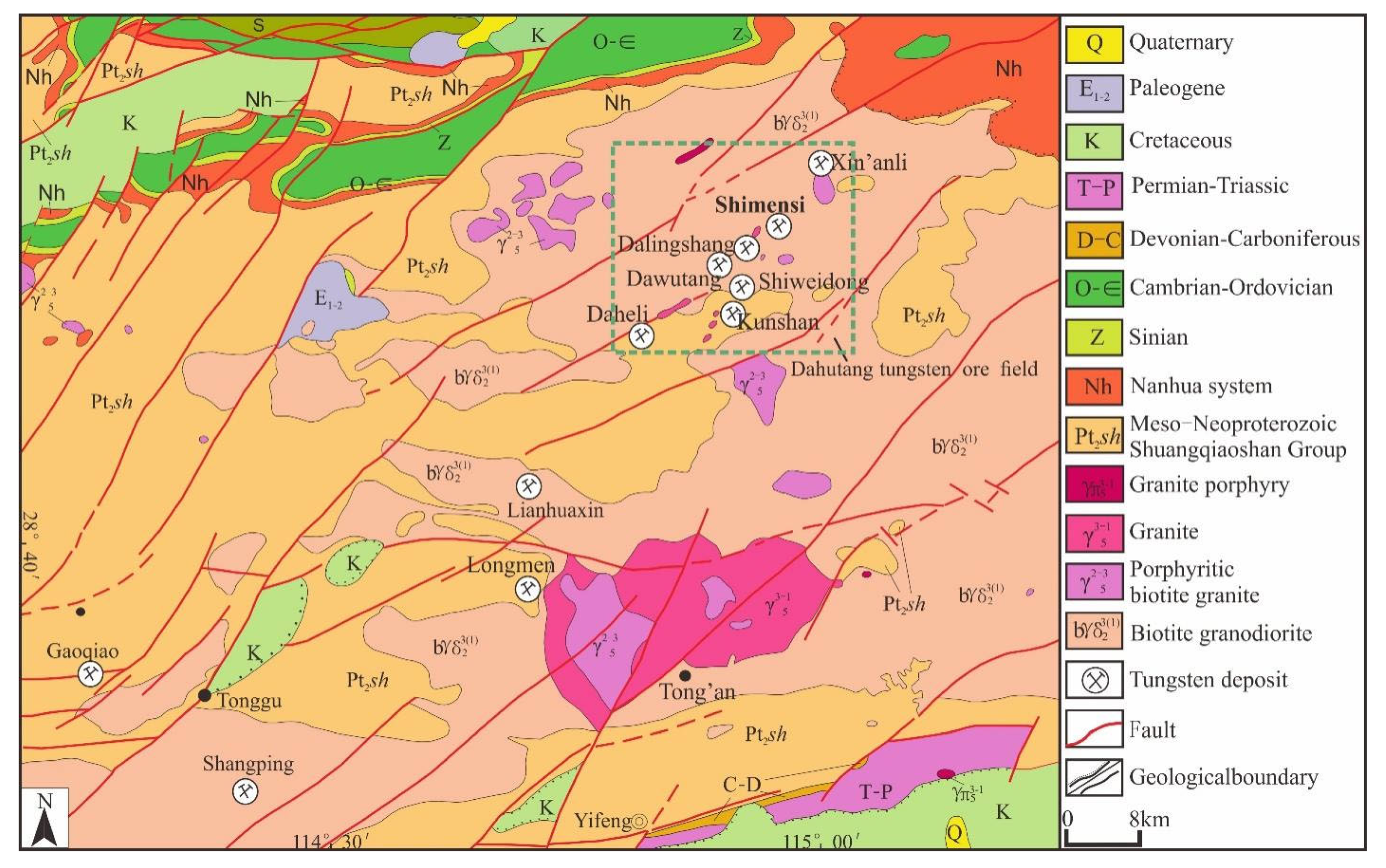

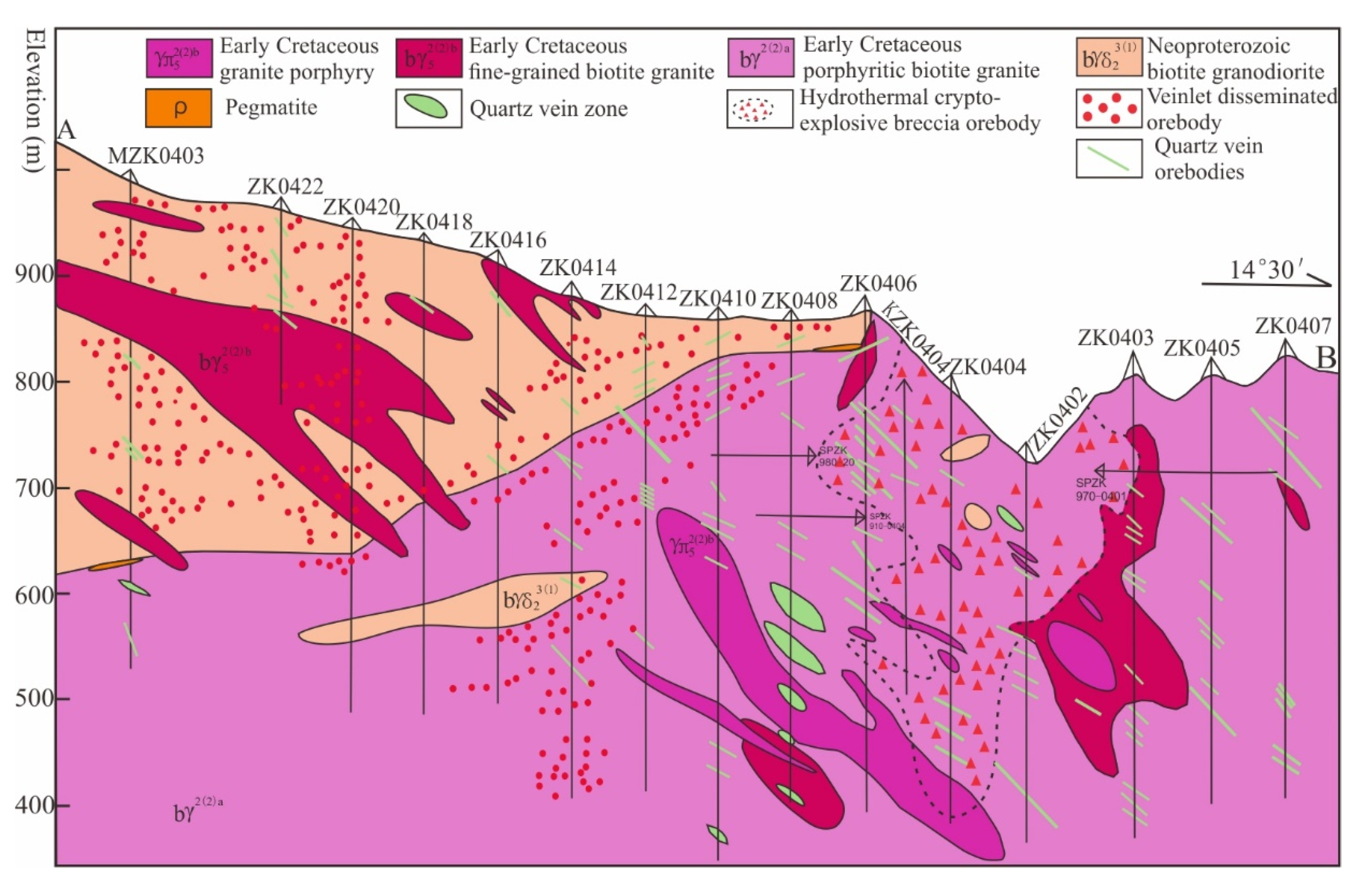
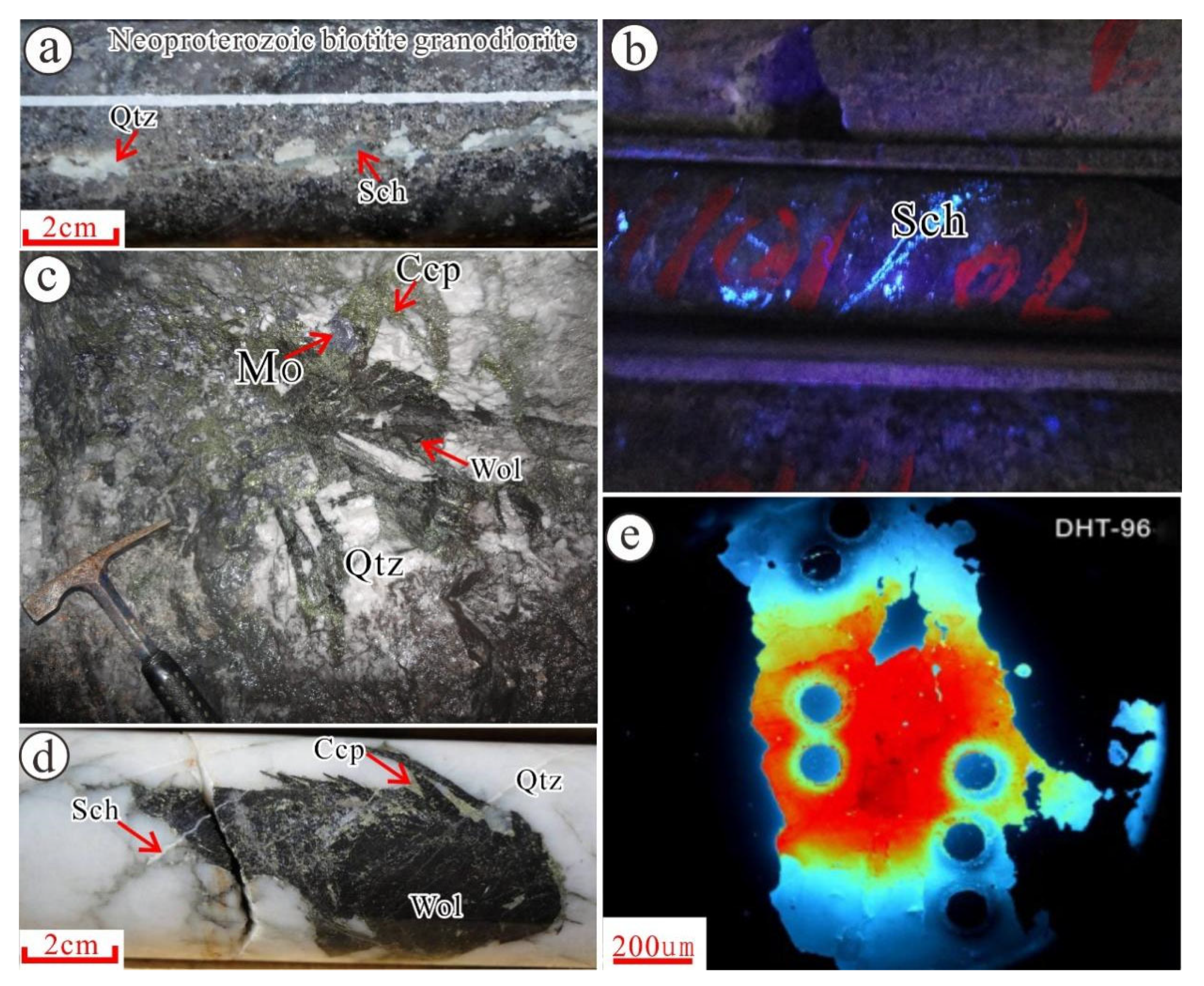
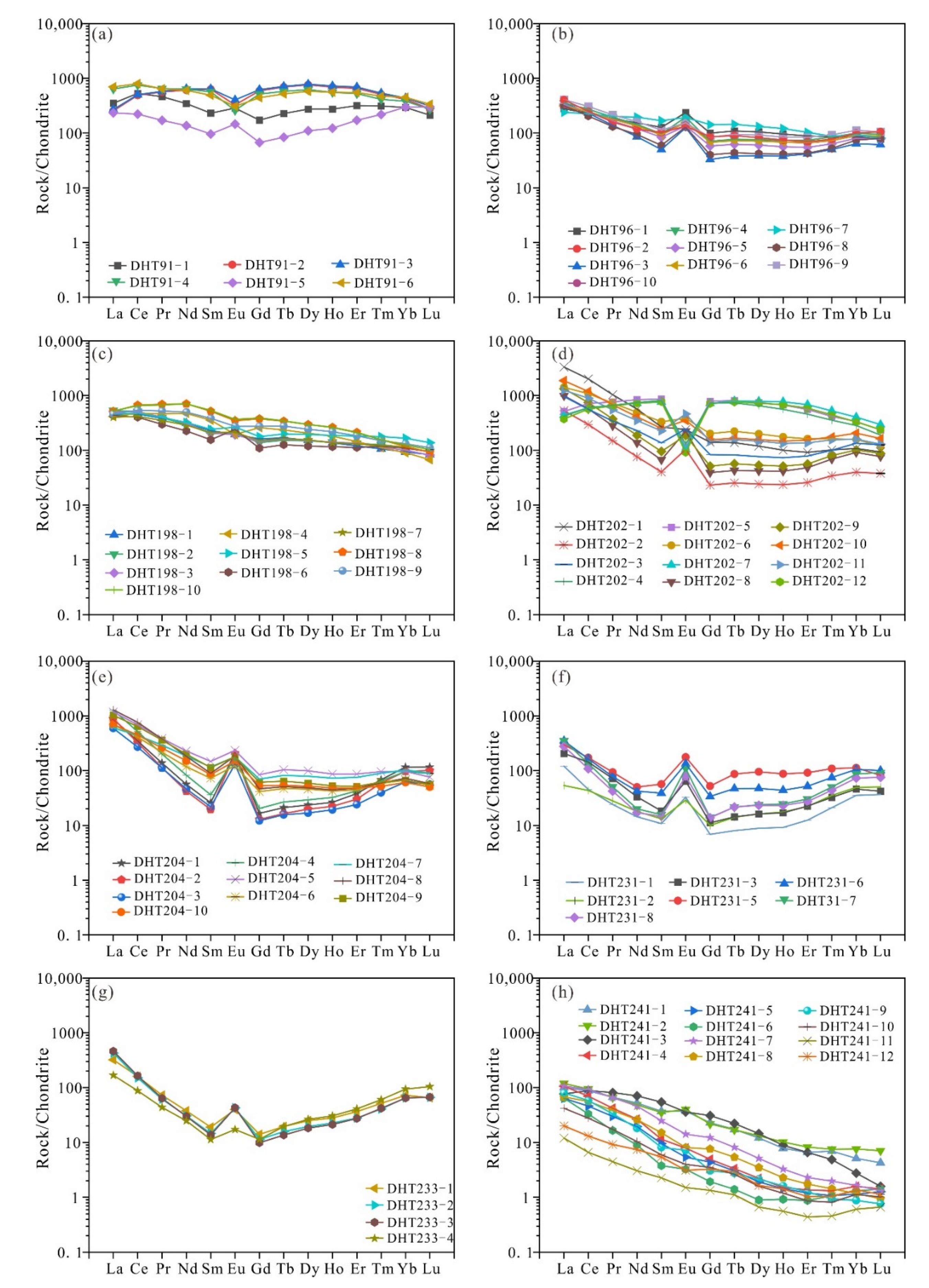
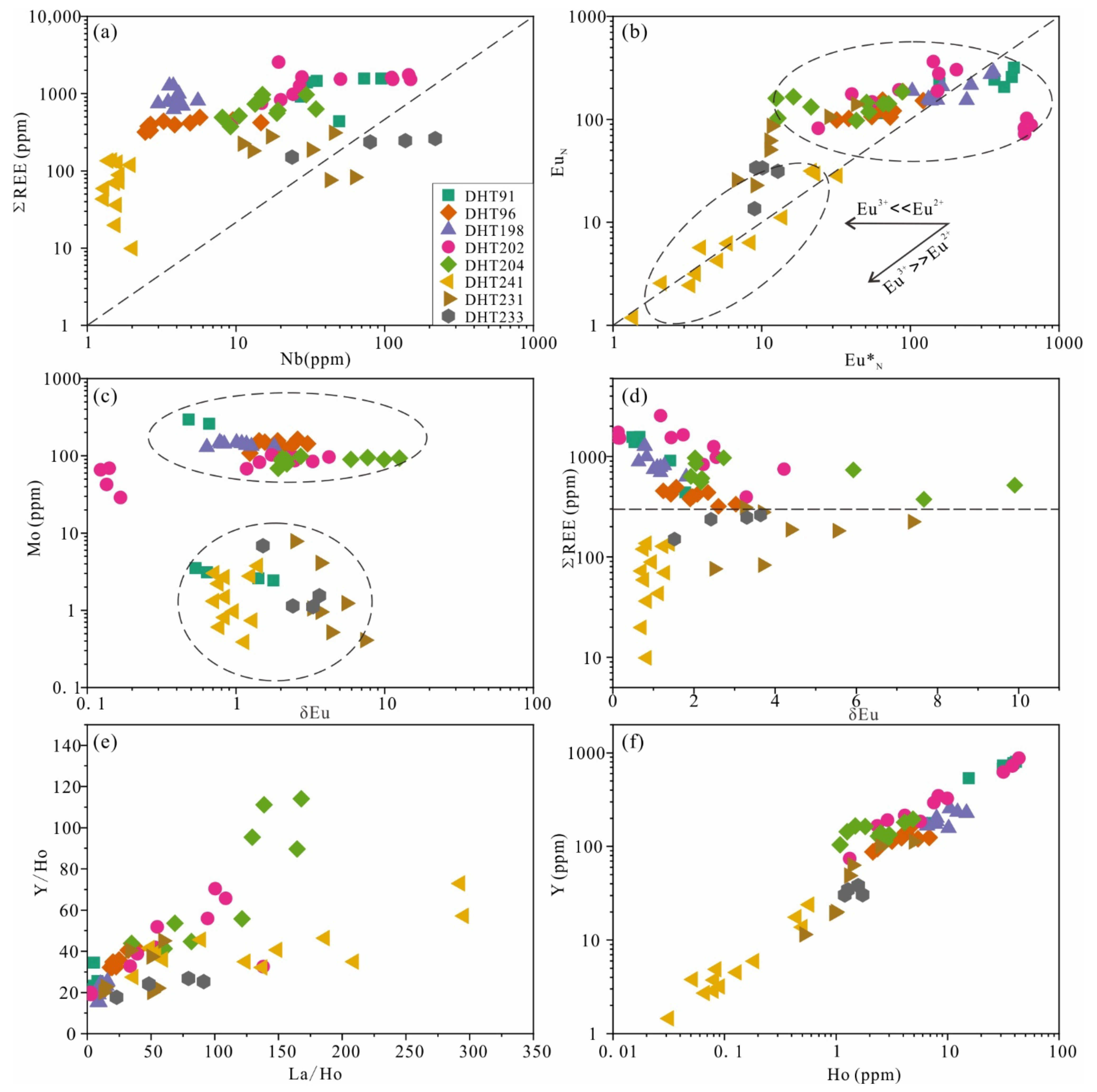
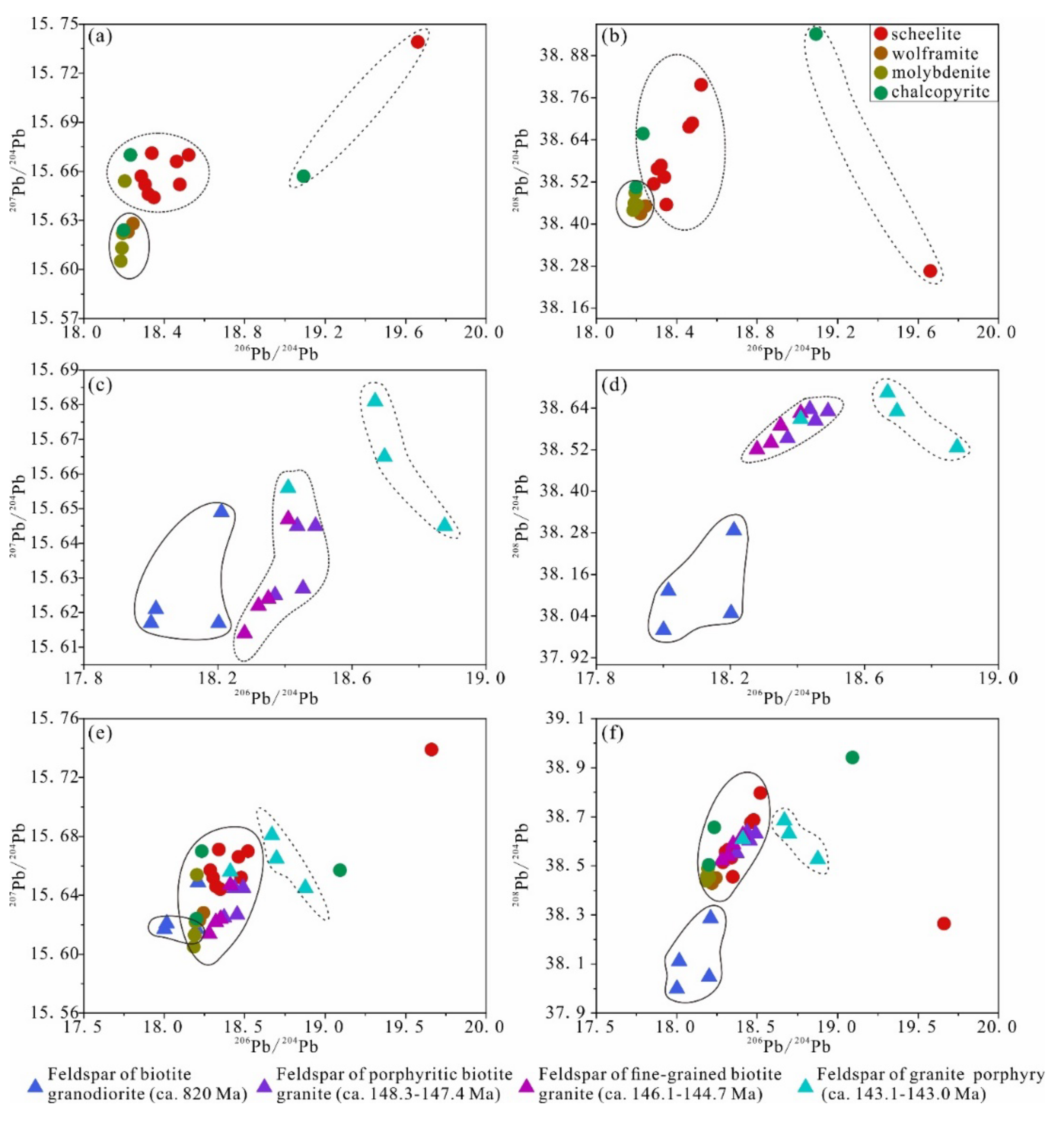
| Elements | DHT91 (n = 6) | DHT96 (n = 10) | DHT198 (n = 10) | DHT202 (n = 12) | ||||||||||||
|---|---|---|---|---|---|---|---|---|---|---|---|---|---|---|---|---|
| Max | Min | Ave | Std | Max | Min | Ave | Std | Max | Min | Ave | Std | Max | Min | Ave | Std | |
| Ti | 2.79 | 0.36 | 0.94 | 0.92 | 0.35 | 0.10 | 0.19 | 0.08 | 0.73 | 0.13 | 0.37 | 0.22 | 31.65 | 0.10 | 3.87 | 10.42 |
| Sr | 120.80 | 62.02 | 84.89 | 24.81 | 460.06 | 196.03 | 353.98 | 75.93 | 369.23 | 182.41 | 273.60 | 62.64 | 198.37 | 29.31 | 133.87 | 65.32 |
| Y | 802.65 | 177.57 | 616.01 | 235.04 | 167.17 | 87.53 | 123.48 | 22.57 | 255.49 | 156.88 | 201.98 | 33.16 | 876.26 | 74.33 | 395.84 | 269.02 |
| Nb | 95.07 | 27.30 | 51.65 | 27.13 | 14.72 | 2.45 | 5.23 | 3.98 | 5.56 | 2.99 | 3.96 | 0.68 | 149.28 | 9.33 | 59.38 | 54.01 |
| Mo | 294.40 | 2.43 | 94.21 | 141.89 | 163.74 | 107.53 | 138.17 | 19.93 | 149.82 | 129.60 | 140.91 | 6.96 | 102.55 | 28.76 | 76.35 | 22.66 |
| Ba | 0.28 | 0.05 | 0.12 | 0.08 | 0.55 | 0.08 | 0.21 | 0.17 | 0.14 | 0.02 | 0.07 | 0.04 | 0.08 | 0.01 | 0.04 | 0.02 |
| La | 165.75 | 55.32 | 96.58 | 49.10 | 96.62 | 56.95 | 78.21 | 12.52 | 126.86 | 95.05 | 111.75 | 11.14 | 787.42 | 88.30 | 265.08 | 200.13 |
| Ce | 489.20 | 136.19 | 336.25 | 127.29 | 187.82 | 125.18 | 149.95 | 17.18 | 409.60 | 245.75 | 313.21 | 54.73 | 1234.60 | 181.02 | 501.39 | 275.12 |
| Pr | 61.89 | 16.23 | 48.61 | 17.16 | 20.45 | 12.47 | 16.62 | 2.55 | 65.89 | 28.36 | 43.55 | 12.64 | 98.26 | 14.17 | 54.32 | 23.33 |
| Nd | 301.33 | 63.70 | 231.38 | 97.38 | 91.32 | 40.03 | 63.12 | 15.13 | 329.86 | 105.19 | 193.22 | 81.75 | 393.34 | 35.49 | 213.62 | 123.98 |
| Sm | 98.13 | 14.68 | 67.75 | 34.76 | 25.71 | 7.63 | 15.14 | 5.11 | 81.94 | 23.85 | 46.52 | 20.89 | 132.27 | 6.15 | 59.08 | 49.17 |
| Eu | 23.39 | 8.44 | 16.72 | 4.94 | 13.70 | 7.27 | 9.40 | 2.09 | 21.33 | 11.19 | 14.45 | 3.73 | 26.73 | 5.32 | 12.71 | 7.16 |
| Gd | 127.75 | 13.82 | 82.59 | 47.19 | 29.27 | 6.77 | 15.43 | 6.39 | 79.96 | 22.48 | 44.80 | 20.79 | 161.59 | 4.75 | 64.80 | 64.89 |
| Tb | 26.63 | 3.14 | 17.54 | 9.61 | 5.41 | 1.42 | 3.02 | 1.17 | 12.94 | 4.72 | 8.11 | 2.98 | 30.34 | 0.95 | 12.44 | 12.43 |
| Dy | 198.23 | 27.95 | 132.33 | 68.89 | 33.51 | 9.81 | 19.63 | 7.11 | 75.28 | 30.22 | 49.78 | 16.11 | 199.11 | 6.12 | 78.79 | 79.38 |
| Ho | 41.14 | 6.94 | 27.59 | 13.54 | 6.86 | 2.14 | 4.09 | 1.41 | 14.90 | 6.56 | 10.09 | 3.03 | 43.61 | 1.33 | 16.18 | 16.49 |
| Er | 114.75 | 28.43 | 80.35 | 33.45 | 17.05 | 6.88 | 11.45 | 3.23 | 35.20 | 18.58 | 25.92 | 6.17 | 113.11 | 4.26 | 41.90 | 40.31 |
| Tm | 13.70 | 5.57 | 10.47 | 3.15 | 2.36 | 1.28 | 1.88 | 0.37 | 4.52 | 2.71 | 3.42 | 0.61 | 13.35 | 0.87 | 5.56 | 4.31 |
| Yb | 76.39 | 49.87 | 64.41 | 11.66 | 19.09 | 10.83 | 15.14 | 2.36 | 28.22 | 15.39 | 19.75 | 3.70 | 68.51 | 6.79 | 33.29 | 19.62 |
| Lu | 8.53 | 5.39 | 7.24 | 1.08 | 2.67 | 1.56 | 2.18 | 0.34 | 3.49 | 1.71 | 2.43 | 0.48 | 7.49 | 0.96 | 3.79 | 1.95 |
| Ta | 9.38 | 6.71 | 8.03 | 1.05 | 10.57 | 9.04 | 9.68 | 0.43 | 9.73 | 7.92 | 8.92 | 0.55 | 12.73 | 9.02 | 10.75 | 1.21 |
| ΣREE | 1567.81 | 438.70 | 1219.79 | 452.88 | 493.58 | 319.18 | 405.24 | 52.62 | 1268.63 | 627.08 | 886.99 | 224.59 | 2548.12 | 394.60 | 1362.96 | 566.61 |
| LaN/ YbN | 2216.90 | 282.02 | 1479.86 | 803.80 | 543.16 | 142.31 | 302.33 | 113.42 | 1602.70 | 458.47 | 903.86 | 412.58 | 2894.70 | 107.02 | 1219.24 | 1121.82 |
| δEu | 1.79 | 0.48 | 0.92 | 0.55 | 3.03 | 1.24 | 2.01 | 0.54 | 1.81 | 0.64 | 1.06 | 0.33 | 4.22 | 0.12 | 1.64 | 1.37 |
| Element | DHT204 (n = 10) | DHT231 (n = 7) | DHT233 (n = 4) | DHT241 (n = 12) | ||||||||||||
| Max | Min | Ave | Std | Max | Min | Ave | Std | Max | Min | Ave | Std | Max | Min | Ave | Std | |
| Ti | 0.42 | 0.09 | 0.24 | 0.12 | 1.98 | 0.08 | 0.87 | 0.91 | 2.98 | 0.44 | 1.85 | 1.21 | 7.99 | 0.09 | 1.39 | 2.35 |
| Sr | 198.67 | 124.53 | 167.22 | 22.33 | 1581.63 | 88.21 | 749.71 | 723.32 | 200.79 | 139.52 | 161.63 | 26.89 | 185.41 | 94.51 | 141.09 | 35.13 |
| Y | 196.17 | 104.00 | 147.04 | 29.40 | 112.82 | 11.47 | 53.74 | 40.61 | 38.08 | 30.38 | 33.32 | 3.68 | 23.92 | 1.45 | 7.35 | 7.10 |
| Nb | 34.44 | 8.10 | 17.35 | 8.67 | 63.05 | 11.09 | 32.08 | 19.49 | 219.04 | 23.81 | 115.12 | 83.43 | 2.02 | 1.29 | 1.58 | 0.23 |
| Mo | 98.51 | 68.80 | 88.33 | 8.68 | 7.84 | 0.41 | 2.30 | 2.74 | 6.84 | 1.11 | 2.66 | 2.80 | 3.76 | 0.39 | 1.73 | 1.12 |
| Ba | 0.06 | 0.02 | 0.03 | 0.02 | 0.12 | 0.02 | 0.08 | 0.04 | 0.27 | 0.08 | 0.16 | 0.08 | 0.64 | 0.02 | 0.23 | 0.23 |
| La | 305.76 | 140.98 | 216.44 | 63.68 | 83.39 | 12.66 | 56.15 | 27.36 | 109.66 | 39.89 | 81.87 | 31.38 | 28.27 | 2.84 | 16.99 | 8.12 |
| Ce | 468.25 | 165.60 | 297.80 | 100.80 | 105.78 | 26.56 | 71.13 | 32.60 | 100.46 | 53.77 | 86.25 | 21.91 | 57.80 | 4.04 | 34.36 | 19.14 |
| Pr | 36.83 | 10.63 | 23.40 | 10.22 | 8.91 | 2.29 | 5.27 | 2.51 | 6.89 | 4.14 | 5.73 | 1.15 | 7.72 | 0.42 | 3.73 | 2.43 |
| Nd | 106.98 | 19.79 | 60.58 | 32.53 | 23.44 | 6.71 | 13.02 | 6.59 | 17.67 | 11.57 | 14.38 | 2.51 | 33.08 | 1.42 | 13.13 | 10.02 |
| Sm | 22.66 | 2.98 | 11.14 | 6.96 | 8.69 | 1.65 | 3.68 | 2.63 | 2.90 | 1.73 | 2.24 | 0.49 | 8.34 | 0.34 | 2.72 | 2.53 |
| Eu | 13.63 | 7.17 | 10.23 | 2.03 | 10.27 | 1.68 | 5.18 | 3.15 | 2.49 | 1.00 | 2.07 | 0.72 | 2.32 | 0.09 | 0.81 | 0.85 |
| Gd | 17.27 | 2.50 | 8.60 | 5.27 | 10.74 | 1.41 | 4.16 | 3.41 | 2.88 | 2.03 | 2.40 | 0.35 | 6.36 | 0.27 | 2.02 | 2.04 |
| Tb | 3.89 | 0.58 | 1.80 | 1.10 | 3.25 | 0.30 | 1.14 | 1.04 | 0.73 | 0.51 | 0.64 | 0.11 | 0.83 | 0.04 | 0.27 | 0.28 |
| Dy | 25.25 | 4.28 | 12.03 | 6.81 | 24.15 | 2.25 | 8.37 | 7.61 | 6.70 | 4.64 | 5.66 | 1.02 | 3.67 | 0.17 | 1.26 | 1.31 |
| Ho | 4.91 | 1.09 | 2.54 | 1.24 | 4.95 | 0.52 | 1.80 | 1.52 | 1.73 | 1.20 | 1.45 | 0.25 | 0.58 | 0.03 | 0.19 | 0.19 |
| Er | 14.34 | 3.98 | 8.10 | 3.16 | 15.17 | 2.06 | 6.10 | 4.48 | 6.79 | 4.53 | 5.49 | 1.11 | 1.36 | 0.07 | 0.45 | 0.45 |
| Tm | 2.45 | 1.01 | 1.66 | 0.43 | 2.78 | 0.54 | 1.34 | 0.77 | 1.54 | 1.04 | 1.24 | 0.23 | 0.19 | 0.01 | 0.06 | 0.06 |
| Yb | 19.70 | 10.32 | 14.26 | 3.40 | 19.10 | 6.01 | 12.35 | 5.13 | 16.00 | 10.99 | 12.60 | 2.35 | 1.29 | 0.10 | 0.37 | 0.35 |
| Lu | 2.96 | 1.28 | 1.90 | 0.59 | 2.55 | 0.93 | 1.74 | 0.64 | 2.65 | 1.66 | 1.93 | 0.48 | 0.18 | 0.02 | 0.05 | 0.05 |
| Ta | 10.83 | 8.67 | 9.66 | 0.64 | 9.27 | 8.56 | 8.95 | 0.26 | 26.19 | 9.82 | 16.55 | 7.10 | 9.06 | 7.88 | 8.61 | 0.34 |
| ΣREE | 969.93 | 375.27 | 670.46 | 204.24 | 310.08 | 75.94 | 191.44 | 89.45 | 261.44 | 150.58 | 223.94 | 49.91 | 136.32 | 9.88 | 76.41 | 45.03 |
| LaN/ YbN | 391.69 | 55.54 | 193.61 | 119.78 | 191.28 | 30.20 | 77.28 | 59.43 | 57.22 | 39.84 | 45.77 | 7.97 | 144.20 | 6.08 | 46.25 | 44.99 |
| δEu | 12.57 | 1.93 | 4.92 | 3.91 | 1.41 | 0.76 | 1.02 | 0.25 | 1.29 | 0.72 | 0.92 | 0.25 | 7.39 | 0.72 | 3.50 | 1.76 |
| Sample No. | Mineral | Ore or Rock Type | 206Pb/204Pb | 207Pb/204Pb | 208Pb/204Pb | Sample No. | Mineral | Ore or Rock Type | 206Pb/204Pb | 207Pb/204Pb | 208Pb/204Pb |
|---|---|---|---|---|---|---|---|---|---|---|---|
| SMT1 | Scheelite | Veinlet disseminated | 18.521 | 15.670 | 38.797 | SM11 | Feldspar | Fine-grained biotite granite | 18.350 | 15.624 | 38.589 |
| SMT2 | Scheelite | Veinlet disseminated | 18.322 | 15.646 | 38.567 | SM12 | Feldspar | Fine-grained biotite granite | 18.280 | 15.614 | 38.521 |
| SMT3 | Scheelite | Veinlet disseminated | 18.339 | 15.671 | 38.533 | SM31 | Feldspar | Fine-grained biotite granite | 18.410 | 15.647 | 38.626 |
| SMT4 | Scheelite | Veinlet disseminated | 18.286 | 15.657 | 38.514 | SM52 | Feldspar | Fine-grained biotite granite | 18.321 | 15.622 | 38.540 |
| SMT5 | Scheelite | Veinlet disseminated | 18.462 | 15.666 | 38.677 | SM29 | Feldspar | Granite porphyry | 18.877 | 15.645 | 38.527 |
| SMT6 | Scheelite | Veinlet disseminated | 18.348 | 15.644 | 38.455 | SM30 | Feldspar | Granite porphyry | 18.669 | 15.681 | 38.685 |
| SMT7 | Scheelite | Veinlet disseminated | 18.305 | 15.652 | 38.557 | SM32 | Feldspar | Granite porphyry | 18.410 | 15.656 | 38.609 |
| SMT8 | Scheelite | Veinlet disseminated | 18.478 | 15.652 | 38.687 | SM51 | Feldspar | Granite porphyry | 18.697 | 15.665 | 38.631 |
| SMT9 | Scheelite | Veinlet disseminated | 19.661 | 15.739 | 38.265 | Wo-1 | Wolframite | Thick quartz vein | 18.219 | 15.623 | 38.429 |
| SM18 | Feldspar | Biotite granodiorite | 18.202 | 15.617 | 38.048 | Wo-2 | Wolframite | Thick quartz vein | 18.245 | 15.628 | 38.451 |
| SM19 | Feldspar | Biotite granodiorite | 18.211 | 15.649 | 38.287 | Mo-1 | Molybdenite | Thick quartz vein | 18.204 | 15.654 | 38.453 |
| SM49 | Feldspar | Biotite granodiorite | 18.015 | 15.621 | 38.112 | Mo-2 | Molybdenite | Veinlet disseminated | 18.184 | 15.605 | 38.439 |
| SM54 | Feldspar | Biotite granodiorite | 18.001 | 15.617 | 38.000 | Mo-3 | Molybdenite | Veinlet disseminated | 18.19 | 15.613 | 38.459 |
| SM05 | Feldspar | Porphyritic biotite granite | 18.371 | 15.625 | 38.553 | Mo-4 | Molybdenite | Hydrothermal crypto-explosive breccia | 18.194 | 15.622 | 38.489 |
| SM50 | Feldspar | Porphyritic biotite granite | 18.454 | 15.627 | 38.604 | Ch-1 | Chalcopyrite | Thick quartz vein | 18.233 | 15.67 | 38.657 |
| SM56 | Feldspar | Porphyritic biotite granite | 18.491 | 15.645 | 38.631 | Ch-2 | Chalcopyrite | Thick quartz vein | 18.199 | 15.624 | 38.504 |
| SM57 | Feldspar | Porphyritic biotite granite | 18.437 | 15.645 | 38.637 | Ch-3 | Chalcopyrite | Hydrothermal crypto-explosive breccia | 19.093 | 15.657 | 38.942 |
Publisher’s Note: MDPI stays neutral with regard to jurisdictional claims in published maps and institutional affiliations. |
© 2022 by the authors. Licensee MDPI, Basel, Switzerland. This article is an open access article distributed under the terms and conditions of the Creative Commons Attribution (CC BY) license (https://creativecommons.org/licenses/by/4.0/).
Share and Cite
Wang, P.; Liang, T.; Jiang, H.; Xiang, X.; Zhong, B. Trace Elements and Pb-O Isotopes of Scheelite: Metallogenic Implications for the Shimensi W-Polymetallic Deposit in South China. Minerals 2022, 12, 1461. https://doi.org/10.3390/min12111461
Wang P, Liang T, Jiang H, Xiang X, Zhong B. Trace Elements and Pb-O Isotopes of Scheelite: Metallogenic Implications for the Shimensi W-Polymetallic Deposit in South China. Minerals. 2022; 12(11):1461. https://doi.org/10.3390/min12111461
Chicago/Turabian StyleWang, Peng, Ting Liang, HongJun Jiang, XinKui Xiang, and Bo Zhong. 2022. "Trace Elements and Pb-O Isotopes of Scheelite: Metallogenic Implications for the Shimensi W-Polymetallic Deposit in South China" Minerals 12, no. 11: 1461. https://doi.org/10.3390/min12111461




